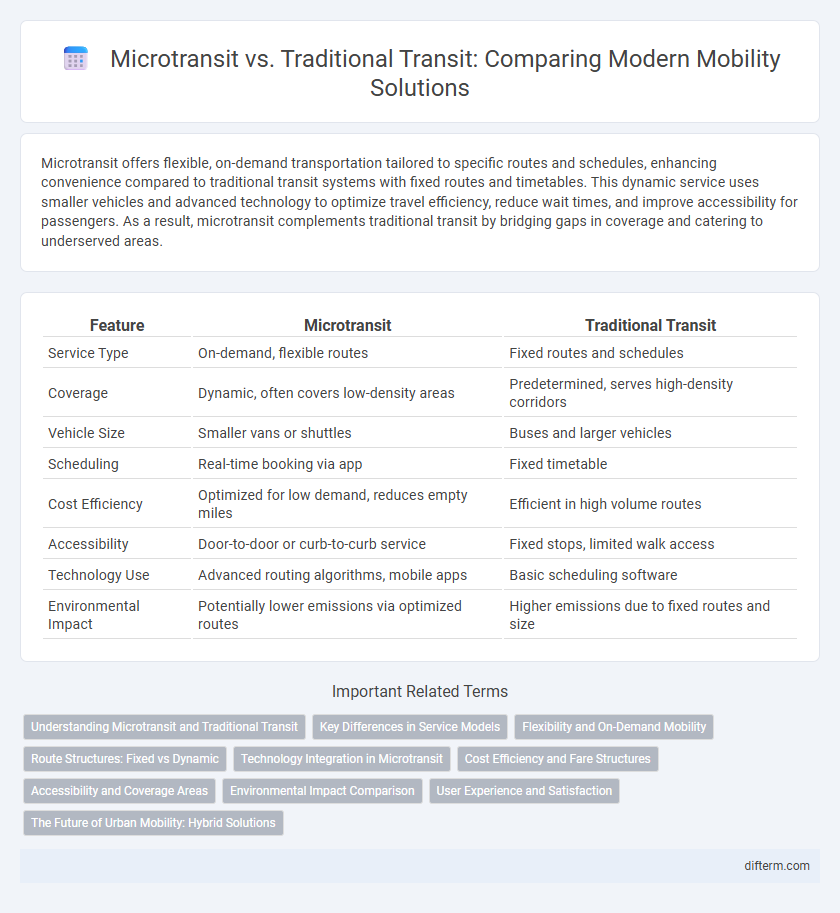Microtransit offers flexible, on-demand transportation tailored to specific routes and schedules, enhancing convenience compared to traditional transit systems with fixed routes and timetables. This dynamic service uses smaller vehicles and advanced technology to optimize travel efficiency, reduce wait times, and improve accessibility for passengers. As a result, microtransit complements traditional transit by bridging gaps in coverage and catering to underserved areas.
Table of Comparison
| Feature | Microtransit | Traditional Transit |
|---|---|---|
| Service Type | On-demand, flexible routes | Fixed routes and schedules |
| Coverage | Dynamic, often covers low-density areas | Predetermined, serves high-density corridors |
| Vehicle Size | Smaller vans or shuttles | Buses and larger vehicles |
| Scheduling | Real-time booking via app | Fixed timetable |
| Cost Efficiency | Optimized for low demand, reduces empty miles | Efficient in high volume routes |
| Accessibility | Door-to-door or curb-to-curb service | Fixed stops, limited walk access |
| Technology Use | Advanced routing algorithms, mobile apps | Basic scheduling software |
| Environmental Impact | Potentially lower emissions via optimized routes | Higher emissions due to fixed routes and size |
Understanding Microtransit and Traditional Transit
Microtransit offers flexible, on-demand transportation services using smaller vehicles, optimizing routes via real-time data to increase efficiency and reduce wait times. Traditional transit relies on fixed routes and schedules with larger vehicles, providing predictable and high-capacity service for urban and suburban areas. Understanding the operational differences highlights microtransit's role in first-mile/last-mile connectivity and traditional transit's strength in managing mass passenger flows.
Key Differences in Service Models
Microtransit operates on flexible routes and schedules tailored to real-time demand, contrasting traditional transit's fixed routes and timetables. Microtransit leverages on-demand booking through mobile apps to optimize passenger pickups, whereas traditional transit relies on predetermined stops and fixed schedules. Cost efficiency and service adaptability in microtransit support first-mile/last-mile connectivity, while traditional transit focuses on high-capacity, longer-distance travel.
Flexibility and On-Demand Mobility
Microtransit offers unparalleled flexibility by dynamically routing vehicles based on real-time demand, contrasting with traditional transit's fixed routes and schedules. This on-demand mobility model significantly reduces wait times and enhances coverage in low-density areas, improving overall accessibility. Integration of advanced algorithms and mobile app booking systems further optimizes route efficiency, making microtransit a scalable solution for modern urban mobility challenges.
Route Structures: Fixed vs Dynamic
Microtransit leverages dynamic route structures that adapt to real-time demand, enabling efficient, on-demand rides within defined service zones. Traditional transit operates on fixed routes with predetermined stops and schedules, providing consistent service but lacking flexibility to respond to fluctuating passenger needs. Dynamic routing in microtransit reduces wait times and maximizes vehicle utilization, enhancing mobility access compared to static, fixed-route systems.
Technology Integration in Microtransit
Microtransit leverages advanced technology integration, including real-time data analytics, dynamic routing algorithms, and mobile app-based booking systems, to offer flexible, on-demand transportation solutions. Traditional transit relies on fixed routes and schedules with limited digital interaction, often resulting in lower adaptability and efficiency. The seamless use of GPS tracking and AI-driven dispatch in microtransit significantly enhances user experience and operational responsiveness compared to conventional public transit systems.
Cost Efficiency and Fare Structures
Microtransit services offer greater cost efficiency compared to traditional transit by utilizing flexible routes and demand-responsive scheduling, which reduces operational expenses and fuel consumption. Fare structures in microtransit are often dynamic, incorporating real-time pricing models that adjust based on demand and distance, whereas traditional transit typically uses fixed fare systems regardless of trip variability. This flexibility in microtransit fare design enhances affordability and aligns costs more closely with service usage, optimizing overall resource allocation.
Accessibility and Coverage Areas
Microtransit enhances accessibility by offering flexible, on-demand routing that serves areas often neglected by traditional fixed-route transit systems. It effectively expands coverage by connecting low-density neighborhoods and transit deserts, providing first-mile/last-mile solutions that improve overall network reach. Traditional transit maintains broad coverage along major corridors but often lacks the adaptability to meet diverse mobility needs in less accessible regions.
Environmental Impact Comparison
Microtransit services reduce carbon emissions by optimizing routes and vehicle occupancy, leading to lower fuel consumption compared to traditional fixed-route transit systems that often run with partial capacity. Electric microtransit fleets further diminish greenhouse gas emissions, supporting urban sustainability goals more effectively than diesel-powered buses. Studies indicate microtransit's flexible, demand-responsive model minimizes vehicle miles traveled, significantly decreasing air pollution and traffic congestion in densely populated areas.
User Experience and Satisfaction
Microtransit offers personalized, on-demand routing that significantly enhances user experience by reducing wait times and increasing convenience compared to traditional fixed-route transit systems. Passengers report higher satisfaction levels due to greater flexibility, seamless app-based booking, and more direct routes tailored to individual travel needs. While traditional transit remains cost-effective for mass movement, microtransit's adaptive service model better addresses urban mobility challenges by prioritizing user-centric solutions.
The Future of Urban Mobility: Hybrid Solutions
Hybrid solutions combining microtransit and traditional transit systems address urban mobility challenges by enhancing flexibility, reducing operational costs, and improving first-mile/last-mile connectivity. Microtransit leverages on-demand, dynamically routed vehicles that fill gaps where fixed routes are inefficient, complementing high-capacity buses and trains on main corridors. Integrating real-time data and smart scheduling platforms drives optimized resource allocation and seamless passenger experiences, positioning hybrid models as a sustainable future for city transportation networks.
microtransit vs traditional transit Infographic

 difterm.com
difterm.com